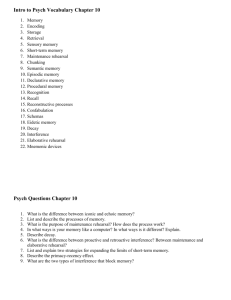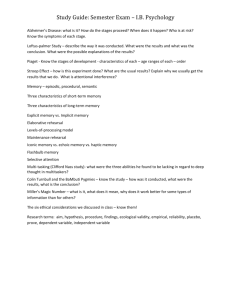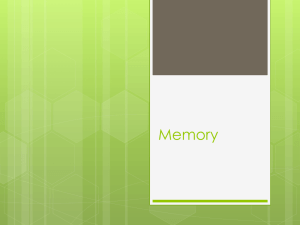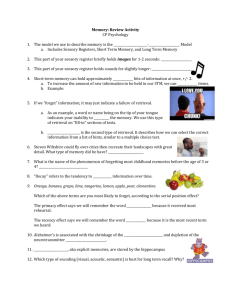Chapter 7, Zimbardo, et al. - University of West Florida
advertisement
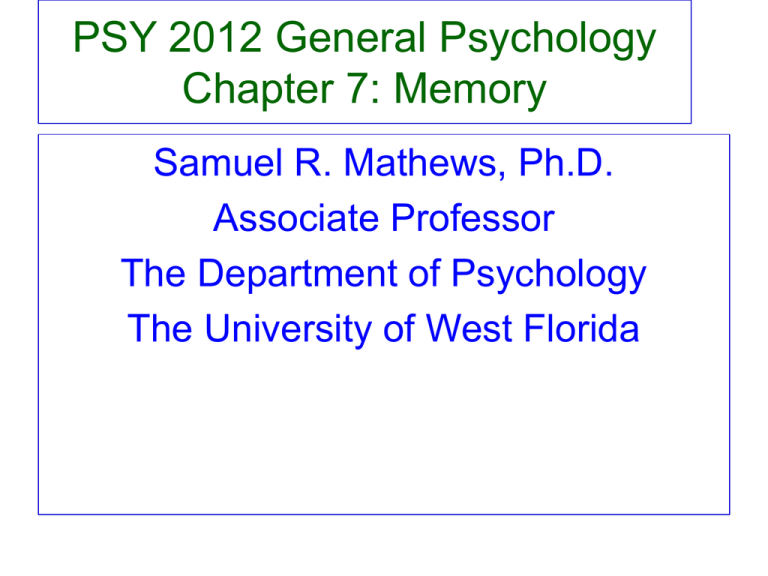
PSY 2012 General Psychology Chapter 7: Memory Samuel R. Mathews, Ph.D. Associate Professor The Department of Psychology The University of West Florida 714786194191 • Write as many numbers as you can remember. • What color was the list of numbers? The Characteristics of Memory • Interpretive: our memory for information is frequently such that we relate new information with old so we interpret new information in light of what we already know • Constructive: our memory fills in gaps in incoming information based on existing knowledge. • Hence, our memory is not typically a reproduction of objective reality Memory • Information flow in memory: – Encoding: the process through which information from the environment is transferred to memory; strategies at encoding impact retrieval – Storage: the process of maintaining information in memory – Retrieval: the process of making information stored in memory accessible for use Atkinson-Shiffrin Model of Memory Computer Metaphor E N V I R O N M E N T Input Devices e.g. Keyboard Sensory Memory •Short duration •Large capacity (Sperling’s work) •Allows further processing Central Processing Unit Short Term or Working Memory •Limited Capacity (7+/-2 Chunks—Miller) •Brief duration without rehearsal •Susceptible to interference Hard Drive or Storage Memory Long Term Memory •Long Duration •Large Capacity •Forgetting and retrieval are problems •Meaningful representations 1776 1984 1941 • Write as many numbers as you can remember. • What color were the numbers? • Next you will see a list of words. Identify which words begin with a vowel. • • • • • • • • • • • • EAGLE HONDA DOG PARROT AUDI LION HAWK OX FORD OWL SHEEP CHRYSLER • Write as many words from the entire list as you can remember. • In the next list remember the words that name vegetables. • • • • • • • • • • • • TUNA CABBAGE NEVADA BROCCOLI BASS BEANS OHIO SNAPPER FLORIDA SHARK WISCONSIN CARROT • Write the words you can remember from the entire list. Working Memory (a.k.a. Short term memory) • Strategies used in working memory determine the likelihood of retrieval from long term memory • Maintenance Rehearsal: Repeating information verbatim – Keeps information in short term or working memory – Tends to be in inaccessible in long term memory over time Working Memory (a.k.a. Short term memory) • Elaborative rehearsal: Expanding on or creating relations among pieces of information and existing knowledge – Chunking information: breaking information into meaningful units (years instead of numbers) – Creating connections with information already known (Pato—image of duck with pot on its head) – Organizing into meaningful units under a superordinate heading (much like the perceptual rule of similarity—those items that tend to be from the same category tend to be grouped in memory) Levels of Processing (Craik & Lockhart, 1972) • Levels range between shallow and deep levels of processing (strategies in working memory): – Shallow: maintenance rehearsal (repetition) or focusing on surface characteristics (does the word begin with a vowel). – Deep: elaborative rehearsal (looking for meaning—does the word name a vegetable) Levels of Processing (Craik & Lockhart, 1972) • Shallow processing requires less effort but results in lower levels of recall; • Deep processing requires more effort but results in increased recall due to: – Increased connections between the to-beremembered information and existing information in memory – Chunking into meaningful units – Increased processing in working memory Implicit/Explicit Memory • Implicit Memory: memories that were acquired incidentally without conscious learning (e.g. stereotypes, typical habits); • Explicit Memory: memories that were acquired through intentional efforts (e.g. words to a song, main ideas of a chapter) – Typically requires mental effort and control Executive Control in Working Memory: Monitoring and Control • Meta-memory: – Knowing what you know and what you do not know – Knowing the limits to your own memory • Metacognition: – Knowing how to study – Knowing how to solve a problem – Knowing strategies to use and using them – Monitoring your mental processes Long Term/Storage Memory • Duration and capacity limits for information are large but based on: – Organization – Rehearsal – Frequency of access Long Term/Storage Memory • Organization – Procedural memories: • Memories for “how” to accomplish some task (physical or mental) – Declarative memories: • Knowing “what” – Episodic Memory: knowledge of personal experiences; typically perceived to be a “personal narrative” – Semantic Memory: knowledge of concepts and facts; usually language-based Long Term/Storage Memory • Organization – Schema Theory: memories are organized in networks of related ideas. • Relations among ideas or concepts based on logical and emotional links (e.g. causal, temporal, superordinate/subordinate; positive or negative associations) • The more relationships between any concept and other concepts the more likely the concept can be accessed. Long Term/Storage Memory • Think of the word farm and list four terms that come to mind. • Now, think about how those words are related to the term “farm.” • Schema theory suggests this is likely the way semantic memories and very likely others are organized Theory of Memory Theory of Type of rehearsal strategy Atkinson Shiffrin Components of S/A Memory Theory Sensory Working Passes info to Depth of Processing Increases likelihood of retrieval from Long Term Impacts storage And retrieval in Elaborative Type of rehearsal strategy Maintenance Extends duration of information in Sample Concept Map for partial Memory Schema Long Term/Storage Memory • Rehearsal and Retrieval from LTM – Depth of processing is related to ease of retrieval. • What rehearsal strategy is most likely to lead to easier retrieval? • What sort of strategy could you use to increase your memory for your lecture notes? • How might you combine rehearsal and organization to help remember something? Long Term/Storage Memory • Frequency of access – Concepts more frequently accessed are more easily remembered – More frequent and varied access leads to greater number of association with the desired concept. Long Term/Storage Memory • Encoding Specificity: – The manner in which we rehearse material is related to the cues that will successfully help retrieve the material – The more ways we encode the information the broader the set of cues we can use to access the information. Memory Failures • Transience—forgetting declines rapidly over time for meaningless material and levels off at a low level • Absentmindedness—loss of a retrieval cue due to a shift in attention Memory Failures • Blocking—interference by similar stimuli – Something you learned earlier impacts your ability to remember something learned more recently: Proactive interference – Something you learned only recently impacts something your learned in the more distant past: Retroactive interference • Elecia recently moved to a new apartment. In her old apartment, the light switch was on the left side of the front door. In her new apartment it is on the right side. When she entered her new apartment she always reached to the left. • Is this proactive or retroactive interference? • Why? Memory Failures • Serial Position Effect: – Information from the beginning of a string of information and from the end of the string is remembered better than that in the middle – Both proactive and retroactive interference are operating. Memory • Human memory is interpretive and constructive; • Our memory does play tricks on us; • The use of strategies that elaborate information to be remembered is more effective than strategies that simply repeat the information. • Even when we are sure of our memories, they can be affected by other factors. Information remembered best: • • • • Object of focused attention Captures our interest Emotionally salient Linked with our existing knowledge or experiences • Rehearsed using elaborative strategies • In your text, page 296 contains hints for study habits based on memory research…

